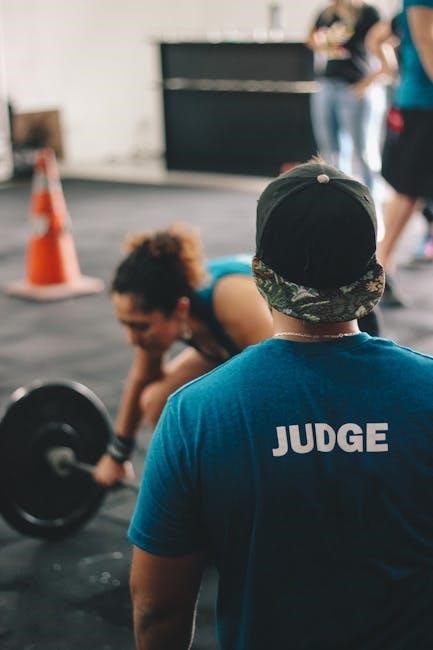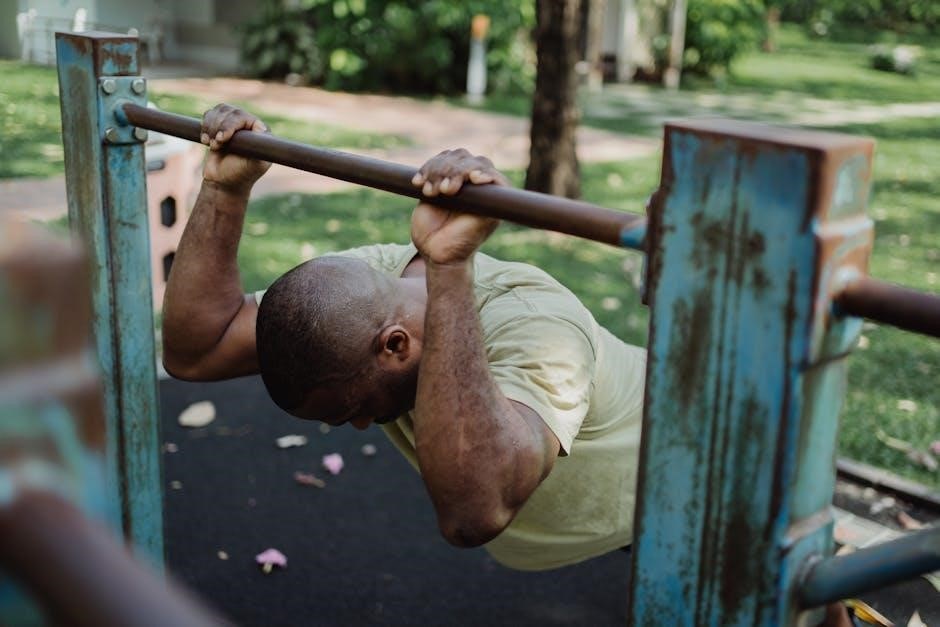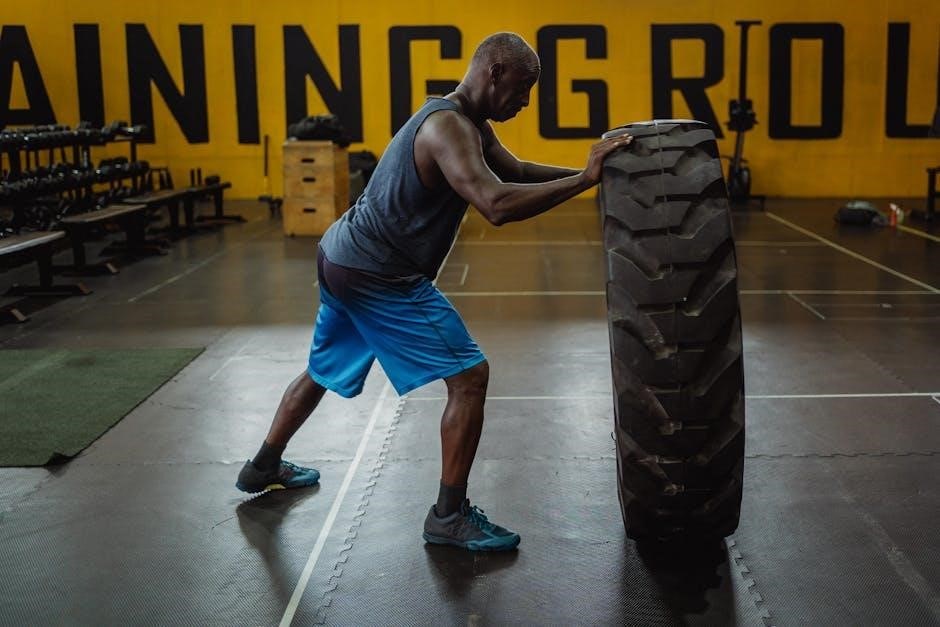The push-pull workout plan is a popular training split focusing on muscle groups that push and pull, enhancing strength and hypertrophy effectively. It’s ideal for balanced muscle development and recovery.
Overview of the Push-Pull-Legs Split
The Push-Pull-Legs (PPL) split divides workouts into three categories: push days for chest, shoulders, and triceps; pull days for back, biceps, and core; and leg days for lower body muscles. This structure allows for balanced training, promoting muscle growth and recovery. Typically performed over 3 to 6 days, it ensures each major muscle group is trained twice weekly, optimizing efficiency for strength and hypertrophy. Its flexibility makes it suitable for both beginners and advanced lifters seeking structured progression.
Benefits of the Push-Pull Workout Routine
The push-pull workout routine offers enhanced efficiency by targeting specific muscle groups, allowing for optimal recovery and balanced growth. It reduces training time by grouping related exercises, improving focus and consistency. This split also minimizes overtraining, as each muscle group is worked strategically. Additionally, it promotes balanced development by ensuring equal attention to pushing and pulling movements, which is essential for overall strength and aesthetics. This approach is highly adaptable, catering to various fitness levels and goals.

How to Set Up Your Push-Pull Workout Plan
Divide your routine into push, pull, and legs days, focusing on compound exercises. Allow recovery days and adjust sets, reps, and weights for progressive overload and balanced growth.
Choosing the Right Exercises for Push Days
Push days target chest, shoulders, and triceps. Start with compound exercises like bench presses and overhead presses for maximum engagement. Include isolation moves such as dumbbell flyes and tricep dips to target specific areas. Ensure a balance between heavy weights for strength and controlled reps for muscle definition. Progress gradually to avoid plateaus and maintain consistent muscle growth.
Choosing the Right Exercises for Pull Days
Pull days focus on back, biceps, and core. Key exercises include deadlifts, barbell rows, lat pulldowns, and pull-ups for compound movements. Incorporate isolation exercises like face pulls and cable rows for detailed targeting. For biceps, use dumbbell curls and hammer curls. Ensure a mix of heavy weights for strength and controlled reps for muscle definition. This balance optimizes muscle engagement and growth, keeping workouts effective and preventing plateaus.
Incorporating Leg Workouts for a Balanced Routine
Leg workouts are crucial for a balanced physique. Include compound exercises like squats, deadlifts, and lunges to target multiple muscle groups. Add isolation movements such as leg curls and leg extensions for focused growth. Aim for 3-4 sets of 8-12 reps for strength and hypertrophy. Consistency in leg training prevents imbalances, enhances overall power, and supports other muscle groups, ensuring a well-rounded fitness routine that promotes both functionality and aesthetics.

Exercises for a Push-Pull Workout Plan
Combine compound and isolation exercises for push and pull days. Focus on chest, shoulders, and triceps for push days, and back, biceps, and core for pull days. Leg exercises ensure full-body development. Use free weights, cables, and machines for variety. Tailor your routine to suit fitness goals, ensuring progressive overload for continuous gains. Consistency and proper form are key to success.
Best Compound Exercises for Push Days
Compound exercises are the cornerstone of push days, targeting multiple muscle groups simultaneously. Bench presses (flat and incline) work the chest, shoulders, and triceps. Overhead presses and lateral raises focus on shoulder development. Incline dumbbell presses target the upper chest, while dips emphasize triceps and chest. These exercises promote overall muscle growth and strength, making them essential for a well-rounded push workout. Incorporate variations to keep the routine dynamic and ensure progressive overload for continuous gains.
Best Isolation Exercises for Pull Days
Isolation exercises on pull days focus on specific muscle groups to enhance definition and balance. Face pulls and rear delt flys target the rear delts, improving posture and shoulder stability. Cable rows isolate the lats, while concentration curls focus solely on the biceps. These exercises help prevent muscle imbalances and promote a symmetrical physique, ensuring comprehensive development without overlapping with compound movements.

Who Should Use the Push-Pull Workout Plan?
This plan is ideal for individuals seeking balanced muscle development and recovery. It suits both beginners and advanced trainees aiming to build strength and muscle symmetry effectively.
Beginners Guide to Push-Pull Workouts
The push-pull workout plan is perfect for beginners, offering a simple and effective way to build strength and muscle. Start with compound exercises like bench presses and pull-ups, focusing on proper form. Aim for 3-4 sets of 8-12 reps per exercise. Incorporate progressive overload by gradually increasing weights. Rest days are crucial for recovery. Pair this routine with a balanced diet and consistent sleep schedule to maximize results. Tracking progress and staying motivated will help you stick to the plan long-term.
Advanced Training Tips for Push-Pull Routines
For advanced lifters, incorporate periodization by alternating rep ranges (hypertrophy and strength phases). Use variations like plyometric push-ups or isometric holds to challenge muscles differently. Experiment with exercise order to prioritize weaker muscle groups. Include accessory work for imbalances and recovery techniques like active recovery days. Adjust rest periods and nutrition to optimize performance. Track progress meticulously to refine the routine and ensure continuous gains without plateaus.

Sample 4-Day Push-Pull Workout Routine
This structured plan splits workouts into push, pull, and leg days for balanced development. Day 1: Push (chest, shoulders, triceps). Day 2: Pull (back, biceps, core). Day 3: Legs. Day 4: Rest or active recovery. Adjust exercises and intensity based on fitness level and goals. Includes compound and isolation movements for comprehensive muscle engagement and growth.
Day 1: Push Workout (Chest, Shoulders, Triceps)
Begin with compound exercises like bench presses and incline presses for chest development. Include overhead presses or lateral raises for shoulders. Triceps dips and pushdowns target triceps. Aim for 3-4 sets of 8-12 reps per exercise. Finish with isolation movements like cable flyes for chest and face pulls for shoulders. This structure ensures balanced muscle engagement and progression. Adjust weights and reps according to fitness level for optimal results and muscle growth.
Day 2: Pull Workout (Back, Biceps, Core)
Focus on compound lifts like deadlifts and barbell rows for back development. Include pull-ups or lat pulldowns for a strong upper back. Target biceps with curls or hammer curls. Core exercises like planks or Russian twists enhance stability. Aim for 3-4 sets of 8-12 reps per exercise. Finish with isolation movements like face pulls for rear delts. Ensure proper form and progression to maximize muscle growth and avoid injury. Adjust sets and reps based on fitness level.
Day 3: Legs Workout
Leg day focuses on compound exercises like squats, deadlifts, and lunges to target quadriceps, hamstrings, and glutes. Include leg presses and leg curls for isolation. Add calf raises for lower leg development. Perform 4-5 sets of 8-12 reps per exercise. Proper form is crucial to prevent injury. Incorporate progressive overload by increasing weight gradually. This ensures continuous muscle growth and strength gains. Keep the intensity high and rest adequately between sets for optimal results. A strong lower body is essential for overall athleticism and balance.
Day 4: Active Recovery or Rest
Day 4 focuses on active recovery or rest to allow your muscles to heal and rebuild. Engage in low-intensity activities like stretching, yoga, or light cardio to promote blood flow without stressing your muscles. This day is crucial for preventing overtraining and maintaining long-term progress. Avoid heavy lifting or high-intensity exercises. Use this time to recharge mentally and physically, ensuring you’re ready for the next training cycle. Rest days are as important as workout days for muscle growth and overall recovery.

Progressive Overload in Push-Pull Workouts
Progressive overload involves gradually increasing weight or resistance to challenge muscles and promote growth. It’s key for continuous strength gains in push-pull routines, ensuring muscles remain stimulated.
How to Increase Weight Safely
To increase weight safely in a push-pull workout, start by adding small increments (2.5-5%) weekly. Focus on maintaining proper form to prevent injury. Gradually increase reps or sets before raising weights. Warm up thoroughly and prioritize recovery to support muscle adaptation. Consistency and patience are key to sustainable strength gains without risking form or health.
Adjusting Reps and Sets for Maximum Gains
Adjusting reps and sets is crucial for maximizing gains in a push-pull workout. For strength, focus on 3-5 sets of 3-6 reps using compound exercises like bench presses and deadlifts. For hypertrophy, aim for 3-4 sets of 8-12 reps with isolation exercises such as lateral raises or bicep curls. Periodically increase reps or sets to challenge muscles and avoid plateaus. Varying rep ranges ensures well-rounded muscle development and prevents overtraining. Consistency and progressive overload are key to sustained growth and strength improvements.

Nutrition and Recovery for Push-Pull Workouts
A balanced diet rich in protein, carbs, and fats fuels recovery and growth. Prioritize hydration, quality sleep, and post-workout nutrition to optimize muscle repair and performance.
Importance of Protein Intake
Protein is essential for muscle repair and growth, particularly in a push-pull workout. Aim for 1.2-2.2 grams of protein per kilogram of body weight daily. Include high-quality sources like lean meats, fish, eggs, and legumes in your meals. Post-workout protein intake within 30-60 minutes helps maximize recovery and muscle synthesis, ensuring optimal gains from your training efforts.
Role of Sleep in Muscle Recovery
Sleep is crucial for muscle recovery, as it repairs and rebuilds tissues. During REM sleep, muscles recover from the strain of push-pull workouts. Aim for 7-9 hours nightly to optimize recovery. Poor sleep can lead to overtraining and stalled progress. Prioritize a consistent sleep schedule, a dark sleep environment, and avoid screens before bed to enhance recovery and support muscle growth effectively.
The push-pull workout plan is an effective way to build strength and hypertrophy. Stick to the routine, incorporate progressive overload, and prioritize nutrition and recovery for optimal results.
Final Tips for Success with Push-Pull Workouts
Consistency is key to achieving results with the push-pull workout plan. Focus on proper form to prevent injuries and maximize muscle engagement. Gradually increase weights to avoid plateaus and ensure progressive overload; Maintain a balanced diet rich in protein and carbs to fuel workouts and aid recovery. Prioritize sleep to allow muscles to repair and grow. Stay disciplined and patient, as muscle growth takes time. Regularly track progress to stay motivated and adjust the routine as needed to keep challenging the body. Remember, recovery is as important as training, so incorporate rest days or active recovery to maintain overall performance and avoid burnout. By following these tips, you can effectively utilize the push-pull workout plan to achieve your fitness goals and enjoy a well-rounded physique.

Leave a Reply
You must be logged in to post a comment.